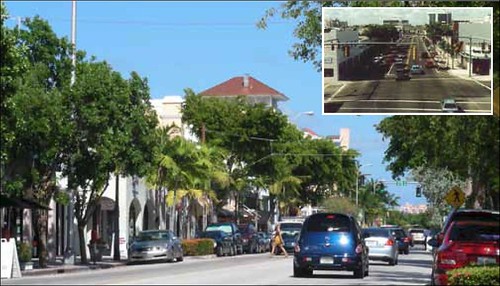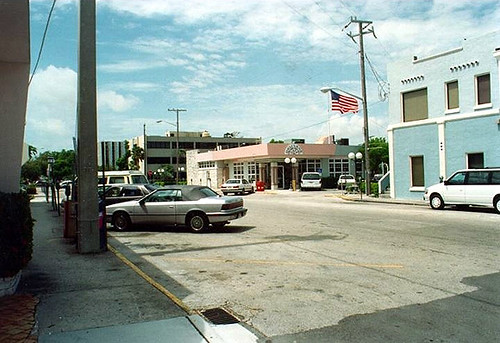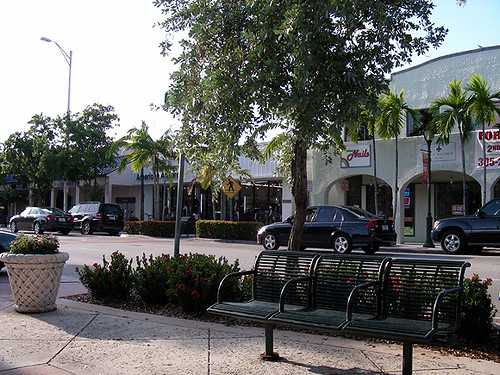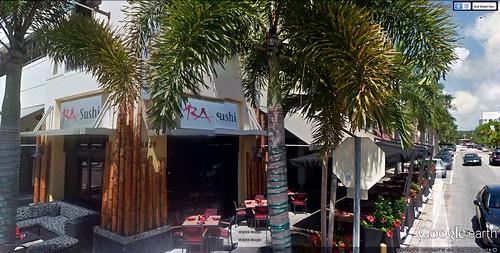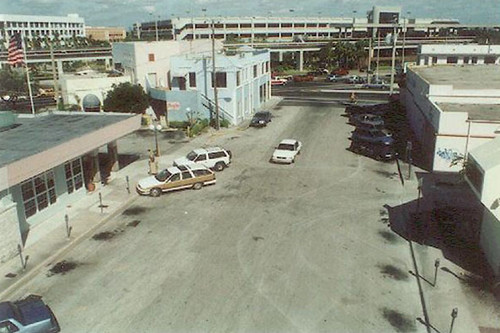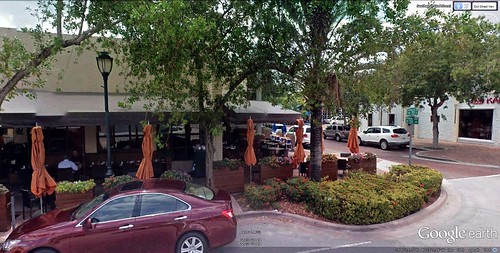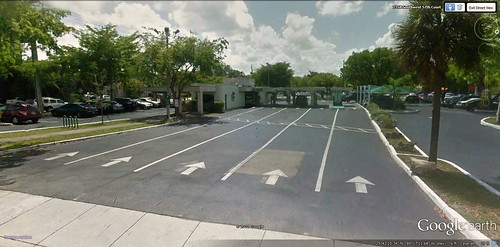How a smarter streetscape is reviving a faded suburban district

Posted December 9, 2013 at 1:56PM
Sunset Drive, South Miami before (inset) and after
One of the great sustainability challenges of the 21st century is revitalizing poorly planned and outdated suburban neighborhoods and commercial districts, consistent with contemporary goals for enhancing walkability and transit access, delivering a sense of place, and doing so in a way that works for both existing and new neighbors. I’m all in for urban revitalization, and in many cities we are making great progress at reviving centrally located neighborhoods. But suburbs present a different set of problems to confront, including greater automobile dependence, lower densities, and a relative lack of people-friendly infrastructure.
We need more and better models of suburban revitalization, and not just in growing affluent areas where investment dollars are relatively easy to come by. What about in places where it remains pragmatically important to accommodate drivers, and where change can occur only gradually, over time?
Before
After
The South Miami Hometown district may be providing such a model. Here’s a description from the website Build a Better Burb:
“During a 1992 community planning process, residents of the City of South Miami – a suburb of Miami – said over and over again, ‘We want our Main Street back.’ The City subsequently adopted a Hometown Plan and created the Hometown District Overlay Code, aimed at making the downtown more people-friendly.
Emphases of the Hometown Plan included transit-oriented development (South Miami has a rail rapid transit station by its downtown), protection for historic structures, pedestrian improvements, and adding residential uses to accommodate a diverse range of incomes. South Miami’s downtown now has revitalized commercial activity, several new and renovated buildings, wider sidewalks, traffic calming features, and a new municipal parking garage lined with restaurants.”
Indeed, just the addition of street trees and landscaping features makes a huge difference to the pedestrian experience.
Before
After
Check out the before and after photos accompanying this article, along with some street views from Google Earth. The Sushi restaurant is on the ground floor of the parking garage.
The planners and the city placed special emphasis on a block of 59th Avenue, known locally as Dorn Avenue. The block leads directly to a crosswalk to the transit station. The planning firm Dover Kohl & Partners, which guided the process for the city, explains why:
“To show the potential for a better South Miami, emphasis was placed on demonstration projects. Neighbors, homebuyers, businesses, investors, and bankers needed their confidence restored. The idea was to choose an area (however small) [and] then totally transform it to create as dramatic and visible an impact as possible. Instead of spending precious funding across large areas, public funds were initially concentrated on these areas.”
The block, images just below, does indeed look amazingly better to this observer’s eyes after its makeover.
Dorn Ave, looking toward the transit station, before
Dorn Ave, after
Streetscape inprovements, Sunset Drive at Dorn Ave
I can’t say the neighborhood is perfect when measured against all popular urbanist parameters. Noodling around Google Earth, I found a five-lane, drive-through ATM just a block or so off the main commercial street; surface parking lots still abound in the neighborhood; to get to the transit station from the main street or from Dorn Avenue, one must cross a six-lane thoroughfare.
Five-lane ATM, South Miami
But the imperfections are part of what makes this example so important. We must be able to show progress even where we are unable to show perfection. Like it or not, rapid and comprehensive change isn’t available in much of America. In the case of South Miami’s Hometown District, the city has a great master plan that will continue to guide further investment and progress toward walkability as more opportunities come up. Meanwhile, what the suburb has achieved so far is really impressive.
Related posts:
- As we remake suburbs, should we guard against "commercial gentrification"? (June 11, 2013)
- How retrofitting a California suburb for walkability is spurring economic development (January 4, 2013)
- Getting to yes on the right kind of suburban change (by Lee Epstein) (October 9, 2012)
- Fixing suburbs with green streets that accommodate everyone (December 20, 2011)
- Can this dead suburban mall be transformed into something better? It's complicated. (June 13, 2011)
- Imaginative suburban retrofits among winners in 'Build a Better Burb' contest (October 8, 2010)
- The country's best suburban retrofit: Bethesda Row reaches maturity (January 28, 2010)
Move your cursor over the images for credit information.
